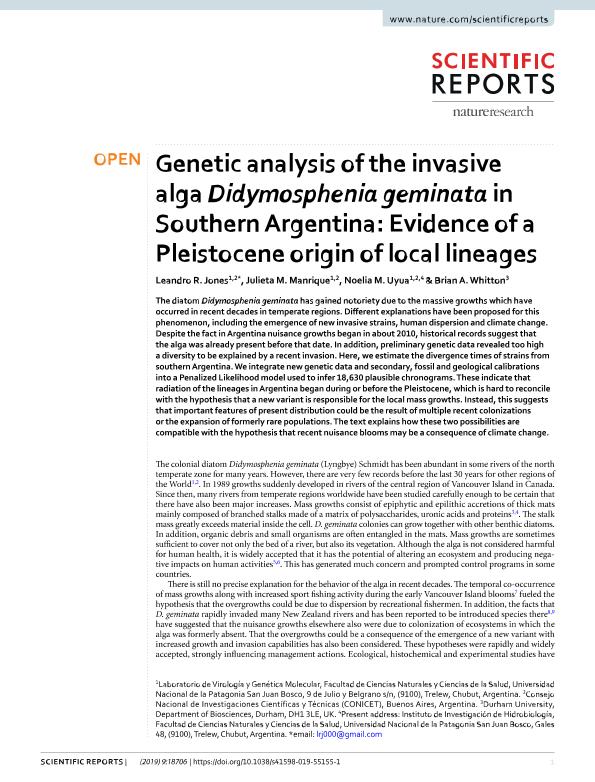Mostrar el registro sencillo del ítem
dc.contributor.author
Jones, Leandro Roberto

dc.contributor.author
Manrique, Julieta Marina

dc.contributor.author
Uyua, Noelia Mariel

dc.contributor.author
Whitton, Brian A.
dc.date.available
2022-10-28T17:02:33Z
dc.date.issued
2019-12
dc.identifier.citation
Jones, Leandro Roberto; Manrique, Julieta Marina; Uyua, Noelia Mariel; Whitton, Brian A.; Genetic analysis of the invasive alga Didymosphenia geminata in Southern Argentina: Evidence of a Pleistocene origin of local lineages; Nature; Scientific Reports; 9; 1; 12-2019; 1-13
dc.identifier.issn
2045-2322
dc.identifier.uri
http://hdl.handle.net/11336/175403
dc.description.abstract
The diatom Didymosphenia geminata has gained notoriety due to the massive growths which have occurred in recent decades in temperate regions. Different explanations have been proposed for this phenomenon, including the emergence of new invasive strains, human dispersion and climate change. Despite the fact in Argentina nuisance growths began in about 2010, historical records suggest that the alga was already present before that date. In addition, preliminary genetic data revealed too high a diversity to be explained by a recent invasion. Here, we estimate the divergence times of strains from southern Argentina. We integrate new genetic data and secondary, fossil and geological calibrations into a Penalized Likelihood model used to infer 18,630 plausible chronograms. These indicate that radiation of the lineages in Argentina began during or before the Pleistocene, which is hard to reconcile with the hypothesis that a new variant is responsible for the local mass growths. Instead, this suggests that important features of present distribution could be the result of multiple recent colonizations or the expansion of formerly rare populations. The text explains how these two possibilities are compatible with the hypothesis that recent nuisance blooms may be a consequence of climate change.
dc.format
application/pdf
dc.language.iso
eng
dc.publisher
Nature

dc.rights
info:eu-repo/semantics/openAccess
dc.rights.uri
https://creativecommons.org/licenses/by/2.5/ar/
dc.subject
Didymosphenia geminata
dc.subject
moco de roca
dc.subject
glaciaciones
dc.subject
alga invasora
dc.subject.classification
Genética y Herencia

dc.subject.classification
Ciencias Biológicas

dc.subject.classification
CIENCIAS NATURALES Y EXACTAS

dc.title
Genetic analysis of the invasive alga Didymosphenia geminata in Southern Argentina: Evidence of a Pleistocene origin of local lineages
dc.type
info:eu-repo/semantics/article
dc.type
info:ar-repo/semantics/artículo
dc.type
info:eu-repo/semantics/publishedVersion
dc.date.updated
2022-10-27T10:23:54Z
dc.journal.volume
9
dc.journal.number
1
dc.journal.pagination
1-13
dc.journal.pais
Estados Unidos

dc.description.fil
Fil: Jones, Leandro Roberto. Consejo Nacional de Investigaciones Científicas y Técnicas; Argentina. Universidad Nacional de la Patagonia "San Juan Bosco". Facultad de Ciencias Naturales y Ciencias de la Salud - Sede Trelew. Laboratorio de Virología y Genética Molecular; Argentina
dc.description.fil
Fil: Manrique, Julieta Marina. Consejo Nacional de Investigaciones Científicas y Técnicas; Argentina. Universidad Nacional de la Patagonia "San Juan Bosco". Facultad de Ciencias Naturales y Ciencias de la Salud - Sede Trelew. Laboratorio de Virología y Genética Molecular; Argentina
dc.description.fil
Fil: Uyua, Noelia Mariel. Universidad Nacional de la Patagonia "San Juan Bosco". Facultad de Ciencias Naturales y Ciencias de la Salud - Sede Trelew. Laboratorio de Virología y Genética Molecular; Argentina. Consejo Nacional de Investigaciones Científicas y Técnicas; Argentina
dc.description.fil
Fil: Whitton, Brian A.. University of Durham; Reino Unido
dc.journal.title
Scientific Reports
dc.relation.alternativeid
info:eu-repo/semantics/altIdentifier/doi/http://dx.doi.org/10.1038/s41598-019-55155-1
Archivos asociados
